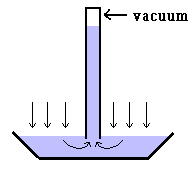
A mercury barometer (animation)
Weather vs. Climate
Weather denotes the state of the atmosphere at a given time and place (and it is always changing).
Climate describes the long term general atmospheric characteristics of a region.
Can you determine which of these statements are about the weather or climate?
The Brewer game was rained out today.
January is the coldest month in Wisconsin.
North Africa is a desert.
Today we reached a high of 40 degrees.
Last night a tornado hit Wales, Wisconsin.
I'm moving to Arizona because it is warm and sunny.
Today's high of 85 degrees hit a record.
(this one I'll give you ... it is both)
When you watch a weather forecast on the TV, the weather person is constantly giving information about the elements of weather. Elements are the properties of the atmosphere that you can measure. Some elements are:
The Elements of Weather
Let's understand two of these elements now ...
Pressure -
Air pressure is the weight of the air above a given point. It is measured with a barometer. Most barometers use mercury (Hg) in a glass column. The pressure of the air will force mercury up the glass column (with a vacuum at the other end of the column) ... so the height of the mercury will indicate the pressure of the air. Quite literally, the air pushes the mercury up the tube and the height depends on how much force the air can provide. Typically at sea level the height of this mercury column reaches 29.9 inches which is about 14.7 pounds per square inch.

A mercury barometer (animation)
As you move up in the atmosphere, the air pressure will always decrease because there is less air above the barometer. In fact, it drops exponentially (similar to the decay rates of radioactive isotopes). For every 3½ miles you move up in the atmosphere, the pressure will drop to half its value. Because of this rapid drop in air pressure with height, Denver will always have a lower pressure than Milwaukee. So to level the playing field, all cities do not give the actual pressure but rather an "adjusted" pressure as if the city were at sea level. With this adjustment, pressure reading differences indicate differences in atmospheric characteristics.
When looking at a weather map, H stands for high pressure and L for low pressure. Quite literally, there is less air over your head when a low pressure system moves in. Two things you should know:
Low pressure is associated with bad weather
High pressure is associated with pleasant weather
... we hope to show you why soon!
Humidity
Humidity is an attempt to indicate the amount of water vapor in the air. Normal air has somewhere between 0 and 4% water vapor content. The interesting thing about water vapor and air is the fact that the amount of water vapor the air can "hold" is dependent on the temperature of the air. At higher temperatures, water has the capacity to hold more vapor. Two terms are often used on a weather forecast - Relative Humidity and Dew Point.
Relative humidity indicates the amount of water vapor in the air relative to the maximum holding capacity (at the same temperature). To say the RH is 30% means the air currently holds 30% of what it could hold (at the same temperature). Most homes in winter are comfortable with RH around 25-30%. You are also very uncomfortable on hot steamy days when the RH is close to 100% because the air is nearly at its limit to hold moisture. This inhibits evaporation ... and you feel miserable because it is the evaporation of sweat which cools you down.
Think of the container as the capacity (maximum amount) of vapor the air can
hold at a given temperature.
Think of the amount of water in the container as the actual vapor content of the
air.
The problem comes when you change the temperature. As you lower the temperature (without changing the amount of vapor in the air) the RH will actually increases! Why? Because at a higher temperature, the air is able to hold more vapor (think of a large container). As you lower the temperature, it is like pouring the same amount of water into progressively smaller containers. Finally you get to a point where the water completely fills the glass and you have just reached the point of saturation known as the dew point. When the weather person says the dew point is 56 degrees, he/she means that if the air were to be cooled down to this temperature, it would produce condensation. Have you ever noticed that on cold days you can "see your breath", or why dew forms on cold window in winter? Can you understand what is happening here?
As the temperature drops, the air is able to hold less vapor.
The reverse situation occurs when you heat air up. You should be able to see why the RH will decrease (and why RH is usually the lowest during the warmest part of the day ... in the afternoon). Can you see why most people have humidifiers in their homes? As you draw in cold outside air in the house and heat it ... the RH drops dramatically.
These concepts are very important in understanding many principles of weather.
Now let's see if you can put the two concepts together!
ŠJim Mihal 2004 - all rights reserved